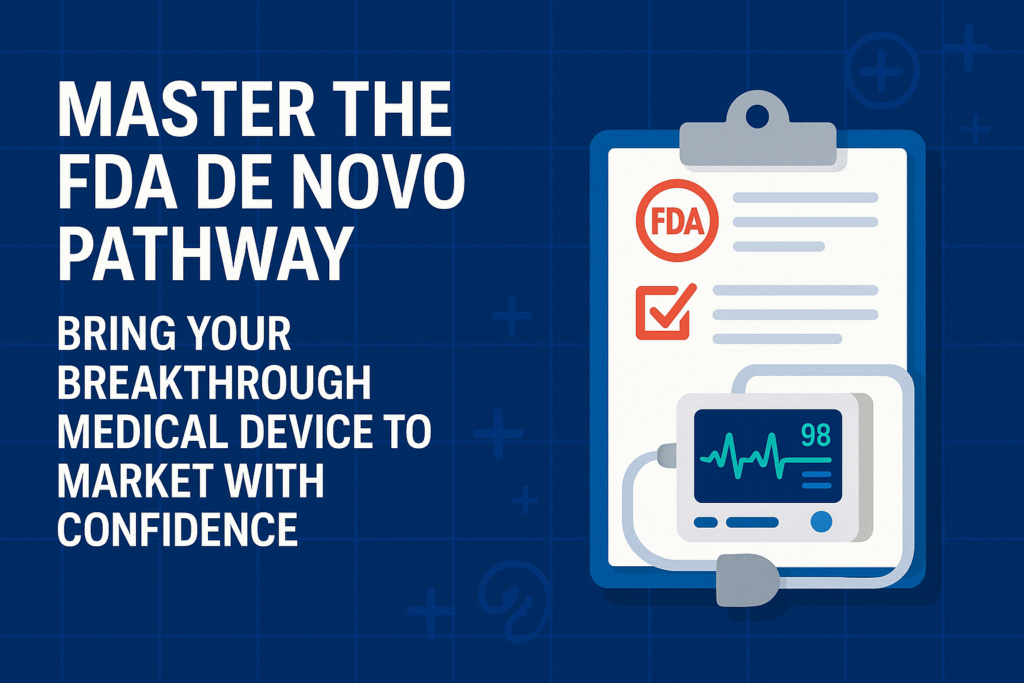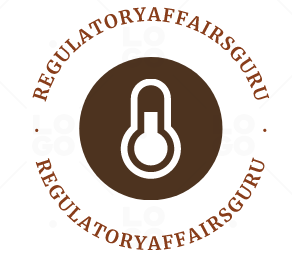
Your Guide to FDA De Novo Success
1️⃣ What is the FDA De Novo Pathway?
The FDA De Novo pathway was created to help new, low-to-moderate-risk medical devices that don’t have a similar product already on the market to get approved for sale in the U.S. If your device is new, with no significant equivalence available under 510(k), but is not high risk and does not require a PMA, De Novo offers a middle ground. It entails filing a detailed request showing the device’s safety and efficacy and suggesting suitable general and special controls to reduce risks. If you are approved, your device is a Class I or II, a new product code and regulation number are established, and your device can then be utilized as a predicate for subsequent 510(k) filings on your behalf or by other manufacturers. This is beneficial for your current product and positions your technology well within the regulatory landscape for scalability. The De Novo process is about the FDA’s commitment to advancing innovation and ensuring patient safety; because of that, startups and established companies must develop new diagnostics, wearables, SaMD, and digital therapeutics that lack an explicit predicate in the U.S. market.
2️⃣ When Should You Use the De Novo Pathway?
The De Novo pathway would be used when your device is new, has no legally marketed predicate in the U.S., and is low-to-moderate risk. Your device isn’t 510(k) because there isn’t a substantially equivalent device, but it would be too burdensome to necessitate a PMA based on your device’s risk profile. For example, a wearable digital therapy incorporating hardware sensors and an AI-based behavioral intervention may not possess a predicate device. Still, it could demonstrate low-to-moderate risk with adequate controls. You should also consider De Novo when you have received a “Not Substantially Equivalent (NSE)” letter after a 510(k) submission, confirming there’s no predicate to be found, and thus you can pursue a Post-NSE De Novo. Or, if you have already determined that there is no predicate, you can submit a Direct De Novo request without going through the 510(k) denial pathway, which is cost- and time-saving. Before that, conduct a thorough regulatory landscape analysis, research similar FDA precedents, and arrange a pre-submission (Q-sub) meeting to confirm the FDA’s agreement to use De Novo for your device to prevent blunders.
3️⃣ De Novo vs. 510(k) vs. PMA: Choosing the Right Pathway
Understanding when to proceed with De Novo, 510(k), or PMA is crucial to avoid delays, unnecessary costs, and misguided strategy. The 510(k) pathway is utilized most often for low-to-moderate-risk devices with a legally marketed predicate device, where you establish substantial equivalence in intended use and technological characteristics. But suppose there is no predicate, and your device is a low-to-moderate risk. In that case, the De Novo pathway is appropriate to classify your device, establishing a new regulation and product code. This pathway will enable your device to act as a predicate for future 510(k) clearances, facilitating market entry for your follow-on or competitor devices. If your product is high-risk, employs a new technology with substantial safety concerns, or needs broad clinical data, a PMA (Premarket Approval) is necessary, which is the most demanding and expensive route. Getting it wrong can result in months of delay and budget waste. Utilize a regulatory environment analysis, risk assessment, and FDA pre-sub talks to set your development and testing on the right path early, saving time and demonstrating regulatory acumen to investors.
4️⃣ Step-by-Step: Building a De Novo Submission
Building a De Novo submission involves meticulous documentation, meeting FDA expectations, and clear-cut evidence demonstrating your device’s safety and effectiveness under general and special controls. First, eligibility can be determined by finding no suitable predicate by thoroughly examining the FDA 510(k) database and similar devices. Conduct a risk analysis demonstrating your device’s low-to-moderate risk, defining proposed special controls. Please consider reaching out to request a pre-submission (Q-Sub) meeting with the FDA to validate your approach. Choose your De Novo type: Choose Post-NSE De Novo if your 510(k) was rejected, or choose Direct De Novo if you were unaware that a predicate existed, which can expedite the process. Prepare your submission with a cover letter indicating the de novo request, administrative forms (FDA 3514, 3601), detailed device description, intended uses, risk/benefit analysis, proposed classification and product code, and evidence of bench, biocompatibility, EMC, software, cybersecurity, and usability testing by FDA standards. Clinical data may be needed if bench data is found to be insufficient. Prepare your submission in FDA eSTAR, which formats and verifies your submission for you, avoiding missing information errors and facilitating FDA review.
5️⃣ File Your De Novo Request
Having prepared and QA-checked your De Novo request internally, you file it via the FDA CDRH Portal or ESG as an interactive eSTAR file to align with the FDA’s structured review process. FDA will review for acceptance within 15 calendar days, ensuring your submission includes all necessary administrative and technical components. Complete, your request goes into Substantive Review, where the FDA’s scientific and engineering personnel review your safety, effectiveness, risk profile, and your submitted general/special controls to reduce identified risks. During this period, the FDA can go into Interactive Review and ask for additional information (AI) to help explain or supplement your information. Providing prompt and clear responses to AI queries is critical to prevent slippage in the review timeline. If satisfied, the FDA will issue a De Novo Grant Order, classifying your device as Class I or II, assigning a new product code and regulation, and clearing it for sale in the United States. The FDA denied the device, which remains Class III, subject to PMA for market clearance. Proper planning, documentation, and preparedness to respond can significantly impact the rate and rate of success of this step.
6️⃣ Timelines
De Novo process timelines are based on the complexity of the devices, the quality of submissions, and the need for additional information. The FDA aims to complete De Novo requests within 150 calendar days. But real timelines run from 6 to 12 months if your product has cutting-edge technology, software, or a new use with extensive testing. Pre-submission alignment with the FDA via Q-Subs reduces review timelines by clarifying expectations at the onset. Using FDA eSTAR can make your review smoother, removing administrative and content-related deficiencies that delay examination. Your in-house preparation timeline must include:
1–2 months of regulatory environment study and risk assessment.
2–4 months for bench, biocompatibility, software, and clinical testing (as needed).
1–2 months for preparation for submission, QA, and assembly of eSTAR.
5–7 months for FDA review and interactive Q&A.
Planning realistically for these timelines will allow you to align your launch expectations, investor communications, and supply chain activities, reducing surprises while maintaining compliance and strategic control over your product launch.
7️⃣ Best Practices for De Novo Success
To grow your chances of first-cycle de novo clearance, use these best practices:
✅ Engage the FDA early through a pre-sub to confirm De Novo suitability and establish testing requirements.
✅ Perform a comprehensive risk analysis that documents identified risks, recommended mitigations, and why special controls can resolve them effectively.
✅ Coordinate testing with FDA-recognized standards of biocompatibility, EMC, electrical safety, and usability to enhance your evidence.
✅ Be consistent in your device description, and utilize indications, labeling, and testing methodology to prevent conflicting information, a typical reason for delays.
✅ Utilize eSTAR for your submission to maximize format, readability, and automatic validation tests.
✅ Plan for required clinical data requirements, especially for SaMD or new digital therapeutics, with an ideally crafted study protocol that meets FDA guidelines.
✅ Maintain tidy, well-organized records and link your evidence logically, making the FDA reviewer’s workflow easier, which can reduce review times.
✅ Respond to AI questions promptly during interactive review so that the clock holds and extensions don’t have to steal months from your review.
These practices, executed consistently, can reduce your time to market, lower your overall cost of regulations, and gain credibility with the FDA and investors.
8️⃣ Common Mistakes to Avoid
Most de novo submissions are delayed or rejected for preventable mistakes:
❌ Justifying low risk without reason: Always record your risk assessment and planned controls.
❌ Omitting predicate analysis: Comparative analysis strengthens your submission even without a predicate.
❌ Submitting poor-quality testing data: Poorly designed or incomplete bench, biocompatibility, or usability testing results in AI requests and delays.
❌ Forgetting software and cybersecurity documentation: Necessary for digital and connected products.
❌ Inconsistent device descriptions or indications across documents: Misalignments confuse reviewers and result in rejection.
❌ Not considering potential clinical evidence requirements: Clinical data will remain necessary for most digital health devices, even if you believe your device falls under low risk.
❌ Not engaging the FDA early: A Pre-Submission (Pre-Sub) can help prevent many of these errors by ensuring alignment with FDA expectations beforehand and reducing the need for rework.
Avoiding these mistakes will reduce your regulatory risks, improve your project timelines and cost management, and enhance the confidence of your staff in the path you have chosen.
9️⃣ Benefits of the De Novo Pathway
✅ Access to the Market for Innovative Devices: The De Novo pathway provides pioneering first-of-its-kind medical devices without predicates with access to the U.S. market without the burdensome time and cost burden of a PMA.
✅ New Predicate Establishment: Once awarded, your De Novo class and product code allow your device and future iterations to clear through the 510(k) process, conserving the time and cost of future clearances.
✅ Investor and Partner Trust: De Novo’s achievement demonstrates your team’s regulatory acumen and your technology’s market viability, making fundraising and partnering easier.
✅ Supports Digital Health and SaMD: De Novo has become a mission-critical route for AI, digital therapeutics, and networked devices lacking apparent precedent in the FDA system.
✅ Alignment and Flexibility: The FDA’s dependence on general and special controls allows your device to reach the market with confidence in its safety and efficacy, aligning patient protection with innovation.
✅ Regulatory Credibility: Illustrates your firm’s track record with the FDA, facilitating easier submissions in the future.
Generally speaking, the De Novo pathway aligns your firm’s innovation with regulatory compliance, making it a strategic choice for both startups and established firms that are developing revolutionary medical devices.
📢 Next Blog Post Preview:
“How to Build a Regulatory Strategy for Your Medical Device: From Design to FDA Submission.”
You will learn:
✅ How to align design, risk analysis, and testing with your intended regulatory pathway.
✅ When to engage FDA.
✅ How to create a timeline that saves time and budget while ensuring compliance.
